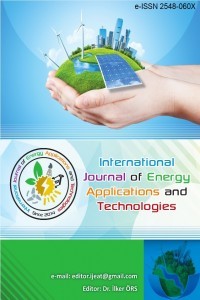Investigation of effects of spark plug gap on vibration, noise and HC emission in a gasoline engine
Investigation of effects of spark plug gap on vibration, noise and HC emission in a gasoline engine
Spark plug gap Vibration, Noise,
___
- [1] Çakıroğlu, M., 1996, “Motorlu Taşıt Trafiğinde Egzoz Emisyonları”, I. Ulusal Ulaşım Sempozyumu, İstanbul, Türkiye.[2] Işıksoluğu, M. A., 1997, “Dizel Motorlu Taşıtların Egzoz Gazındaki Duman Koyuluğu ve Ölçümünde Karşılaşılan Sorunlar”, Mühendis ve Makine Dergisi, sayı 453, Ekim 1997, sayfa 21-25.[3] Alkaya, B., Yıldırım, M. A., 2000, “Taşıt Kaynaklı Kirleticilerin Azaltılma Yöntemleri”, Ekoloji Çevre Dergisi, Ocak-Şubat-Mart 2000, (34):15-20. [4] Soruşbay, C., 2010, “Trafik Kaynaklı Hava Kirliliği ve Otomotiv Sektöründe Alınan Önlemler”, 4. Ulusal Hava Kirliliği ve Kontrolü Sempozyumu, 25-27 Ekim 2010, Ankara, Türkiye. [5] Kuş, R., 2000, ‘‘Motorlu Taşıtlarda Emisyon Kontrol Sistemleri’’, Ders Notları, Konya, Türkiye. [6] Kaytakoğlu, S., Var, F., Öcal, S. E., 1995, “Motorlu Taşıtlardan Kaynaklanan Kirlilik ve Giderme Yöntemleri”, Yanma ve Hava Kirliliği Kontrolü 3. Ulusal sempozyumu, Ankara, Türkiye. [7] Sert, İ., 2008, Balıkesir İl Merkezinde Motorlu Taşıtlardan Kaynaklanan Emisyon Envanterinin Hesaplanması, Yüksek Lisans Tezi, Balıkesir, Türkiye. [8] Haşimoğlu, C., İçingür, Y., Öğüt, H., 2002, “Dizel Motorlarında Egzoz Gazları Re sirkülasyonunun (EGR) Motor Performansı ve Egzoz Emisyonlarına Etkisinin Deneysel Analizi”, Tübitak Dergisi, 26 (2002), 127-135.[9] Schafer, F., Basshuysen, R. V., 1995, “Reduced Emissions and Fuel Consumption in Automobile Engines”, Springer-Verlag Press, 6, Germany.[10] Çetin, E., Eroğlu, M.,Aktürk, N., 2002, “Taşıt Motorlarının Neden Olduğu Gürültü”, Uluslararası Trafik ve Yol Güvenliği Kongresi ve Fuarı, 8-10 Mayıs 2002, Ankara, Türkiye.[11] Aktürk, N., Ünal, Y., 1998, “Gürültü, Gürültüyle Mücadele ve Trafik Gürültüsü”, Gazi Üniv. Fen Bilimleri Enstitüsü Bülteni, Sayı 3, sf. 21 – 32.[12] Toprak, R., Aktürk, N., 2001, “Raylı Ulaşım Sistemlerinin Neden Olduğu Çevresel Gürültü” TMMOB Makine Mühendisleri Odası, İstanbul’da Kent İçi Ulaşım Sempozyumu, 28-30 Haziran, İstanbul, Türkiye.[13] Aktürk, N., Ercan, Y. ve Durmaz, A., 2000, "İzmir Adnan Menderes Havalimanı'nın Sebep Olduğu Gürültünün Belirlenmesi", Gazi Üniv. Fen Bilimleri Enstitüsü Dergisi, C. 13, No 2, Nisan, sf. 289-302, Ankara, Türkiye.[14] Aktürk, N., Gürpınar, M., 2001, Trafik ve Yol Güvenliği Kongresi, 25-27 Nisan, Gazi Üniversitesi, sf. 346-359, Ankara, Türkiye.[15] Öge, A., Öğüt, T., 1998, “Bir Otomobil Egzos Sisteminin İç Performans Analizi”, IV. Ulusal Akustik Kongresi, 29-31 Ekim , Kaş/Antalya, Türkiye.[16] Drugă, C., Barbu, D., Lache, S. 2007, Vibration And The Human Body, Fascicle of Management and Technological Engineering, 6 (16), 168-173.[17] Hostens, I., Ramon, H. 2003, Descriptive Analysis of Combine Cabin Vibrations and Their Effect on the Human Body, Journal of Sound and Vibration, 266: 453-464.[18] Chu, C. C., 1997, Multiaxial Fatigue Life Prediction Method in the Ground Vehicle İndustry, International Journal of Fatigue, 19: 325-330.[19] Fonta, M., Freitas, M., 2009, Marine Main Engine Crankshaft Failure Analysis, Engineering Failure Analysis, 16:1940-1947.[20] Karabulut, H., 2012, Dynamic Model of a Two-Cylinder Four-Stroke İnternal Combustion Engine and Vibration Treatment, International Journal of Engine Research, 13: 616-627.[21] Boysal, A., Rahnejat, H., 1997, Torsional Vibration Analysis of a Multi-Body Single Cylinder İnternal Combustion Engine Model, Applied Mathematical Modelling, 21: 481-493.[22] De la Cruz, M., Theodossiades, S., Rahnejat, H, 2009, An İnvestigation of Manual Transmission Driverattle, Journal of Multi-Body Dynamics, 224: 167-181.[23] Rahnejat, H., 1998, Multi-Body Dynamics: Vehicles, Machines and Mechanisms, Professional Engineering Publishing, SAE, London.
- Yayın Aralığı: Yılda 2 Sayı
- Başlangıç: 2014
- Yayıncı: İlker ÖRS
Proposal of an analog voltmeter PCB’s design layout based on DFMEA methodology for failure reduction
Daniel Bonello, Yuzo Iano, Umberto Neto
Investigation of effects of spark plug gap on vibration, noise and HC emission in a gasoline engine
Nurullah GÜLTEKİN, Murat MAYDA
Solar star projects SAM version 2017.9.5 PVwats version 5 model case study & validation
